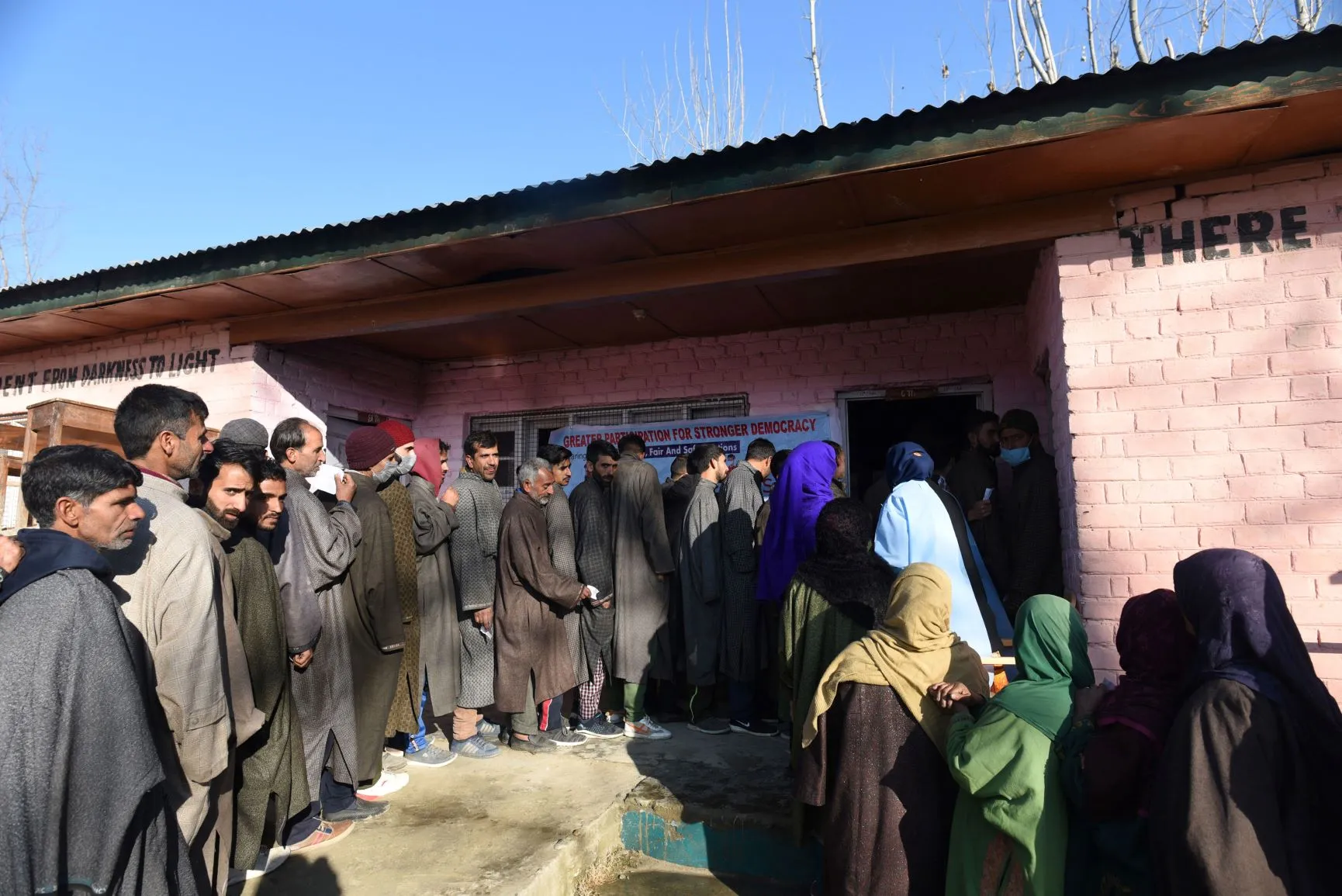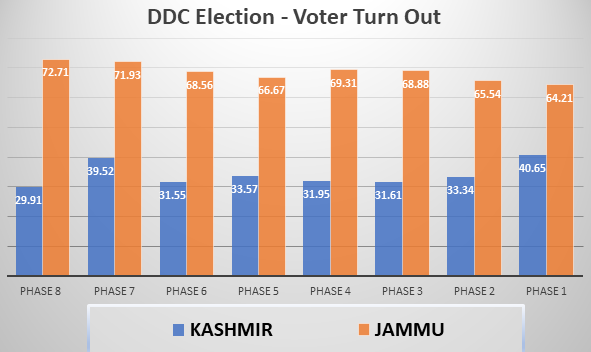-
CENTRES
Progammes & Centres
Location
That the turnout is despite the sweeping constitutional changes and the harshest lockdown that Kashmir has ever witnessed in its troubled history is significant and yet another opportunity for the government to reach out and deliver to the people and address their problems.

The silhouettes of tall poplar trees in the backdrop of the Shalabugh Polling Station in Ganderbal district of Kashmir bear testimony to an emerging dawn. It is quite dark for 7:00 a.m., the temperature is minus 1 degree. An ugly floodlight glares a gush of whiteness, casting shadows of the men and women waiting in long queues to access the ballot box. It is Jammu and Kashmir’s first election after the Constitutional amendments that hollowed out Article 370. This was arguably the biggest gathering witnessed in this area after 5 August 2019.
Prima facie, the significance of these elections lies in the decentralisation of powers to the grassroots level, empowering local Panchayats, Block Development Councils and district-level councils to initiate and implement developmental projects tailor-made to local needs and aspirations. However, the political context in which this election is being held makes it one of the most important elections in the political history of the region.
Post the amendments to Article 370 and the downgrading of the state of J&K into a Union Territory, the political system went out of gear resulting in a much talked about “political vacuum.” Many analysts and Kashmir-watchers feared that the political logjam, wherein all political activity remained suspended for over a year, would have disastrous consequences for the region. The ongoing polls have de-frozen politics in the new Union Territory and have unleashed an enervated streak of positivity for the democratic project.
This was arguably the biggest gathering witnessed in this area after 5 August 2019.
As usual, the voter turnout in the Jammu region of the UT remained high, and in fact was one of the highest recorded in recent years. Ten districts comprising the Jammu region reported 65 percent to 70 percent polling in eight phases of the election. Some of the districts witnessed 75 percent voter turnout in various phases of the polls. The voter turnout in Jammu remained consistent across districts.
The overall voter turnout in Kashmir remained very low in comparison to the Jammu region. However, polling numbers have seen a relative surge in many districts. In the eight phases of polling, the Kashmir region witnessed a polling percentage between 30 to 40 percent.
The lowest voting took place in the South Kashmir districts of Pulwama with a 8.5 percent voter turnout and Shopian with14 percent turnout. In contrast, polling in North and Central Kashmir recorded above 40 percent voter polling across all phases.
The low polling in South Kashmir is also an indication of the levels of alienation and indifference that the people are showing to the democratic process.
The polling percentages of the Kashmir region show that more than 60 percent of voters have decided to boycott or remain away from the elections, even though the election process witnessed negligible violence and there were no election-boycott calls from separatist and militant groups. The low polling in South Kashmir is also an indication of the levels of alienation and indifference that the people are showing to the democratic process.
In successive polls after the killing of Burhan Wani, the south Kashmir region has shown little interest in elections. In the previous panchayat polls, many panchayat seats did not even have a single contesting candidate and, thus, remained vacant. However, this time around all panchayat and DDC constituencies of South Kashmir have more than one contesting candidate and, at least, some polling.
The absence of violence and boycott campaigns is the most remarkable outcome of this election. Barring small instances of violence, the polling has largely remained peaceful. The absence of boycott calls and threats also contributed to the significant surge in voter turnout as compared to earlier elections like the Lok Sabha polls or Panchayat elections.
Political aspirants are no longer deterred from or fearful of contesting the election and this, in itself, will help to bring in more young people into the mainstream of Jammu and Kashmir politics.
The other significant trend in this election is the number of candidates. In places where the mere mention of the word ‘election’ was taboo, multiple independent candidates were in the fray, including candidates of the BJP. Political aspirants are no longer deterred from or fearful of contesting the election and this, in itself, will help to bring in more young people into the mainstream of Jammu and Kashmir politics.
The UT of J&K has undergone a two-year-long governance deficit in the absence of an elected government. Despite the central government and UT administration’s tall claims, developmental activities in the region have not kicked in. Worse, people have faced a callous indifference from the bureaucratic establishment, which remains largely unaccountable. Unlike the politicians, the administrative babus do not have to face the wrath of the people in elections and, therefore, care very little about their concerns. Every vote in this election is a loud cry against bureaucratic ineptitude.
The political setting is also important in understanding the reasons for the reasonably decent turnout during the DDC elections. The coming together of the Peoples’ Alliance for Gupkar Declaration (PAGD) and the BJP’s hard positioning against the amalgamation polarised the political discourse. In this election, the overarching consideration for every voter was to either vote for BJP and its policies or against it.
 Source: http://ceojammukashmir.nic.in/DDC_PE_Phasewise%20turnout.htm
Source: http://ceojammukashmir.nic.in/DDC_PE_Phasewise%20turnout.htm
Even as the mandate of the elected representatives of this election will be limited to developmental schemes, the voters will give their verdict on the performance of the central government, which has indirectly ruled Jammu and Kashmir since June 2018 and implemented sweeping policy changes apart from the constitutional changes of 5 August 2019.
This election is also a litmus test for the constituents of the PAGD. In the aftermath of the ending of the Special Status bestowed by Article 370, the BJP and its ideological apparatus ran full-blown campaigns saying the NC, PDP, Peoples’ Conference and other smaller regional parties have lost the support of the local people. This election might, perhaps, be a dampener for such mythmaking.
More importantly, the parties comprising PAGD were fighting a battle for their existence. The outcome of this election will certainly be a cornerstone for the political future of the Muftis, Abdullahs, Sajjad Lone and other political leaders who are already at the receiving end of the changes brought in by the central government and its agencies.
The outcome of this election will certainly be a cornerstone for the political future of the Muftis, Abdullahs, Sajjad Lone and other political leaders.
Voter turnout in the Kashmir region is an important signal to the Modi government and global audience. The anger and alienation emerging from South Kashmir, which has the region gripped in a new wave of vicious militancy has not subsidised. But at the same time, the faith reposed in the democratic system by people outside the South Kashmir districts tells its own story. That this turnout is despite the sweeping constitutional changes and the harshest lockdown that Kashmir has ever witnessed in its troubled history is significant and yet another opportunity for the government to reach out and deliver to the people and address their problems.
Very often the mainstream media and its talking heads frame Kashmiris and their political expression in binaries of patriots versus anti-nationals, radicalised youth versus security forces, and good Kashmiri versus bad Kashmiri. Such notions have once again been defeated. Jammu and Kashmir and its political expressions comprise of many shades of grey and the pendulum always swings unpredictably. Therefore, before anyone starts to celebrate the successes of this election, the political and security establishment must read the signal emanating from this election correctly and sensitively.
The views expressed above belong to the author(s). ORF research and analyses now available on Telegram! Click here to access our curated content — blogs, longforms and interviews.

Khalid Shah was an Associate Fellow at ORF. His research focuses on Kashmir conflict Pakistan and terrorism.
Read More +